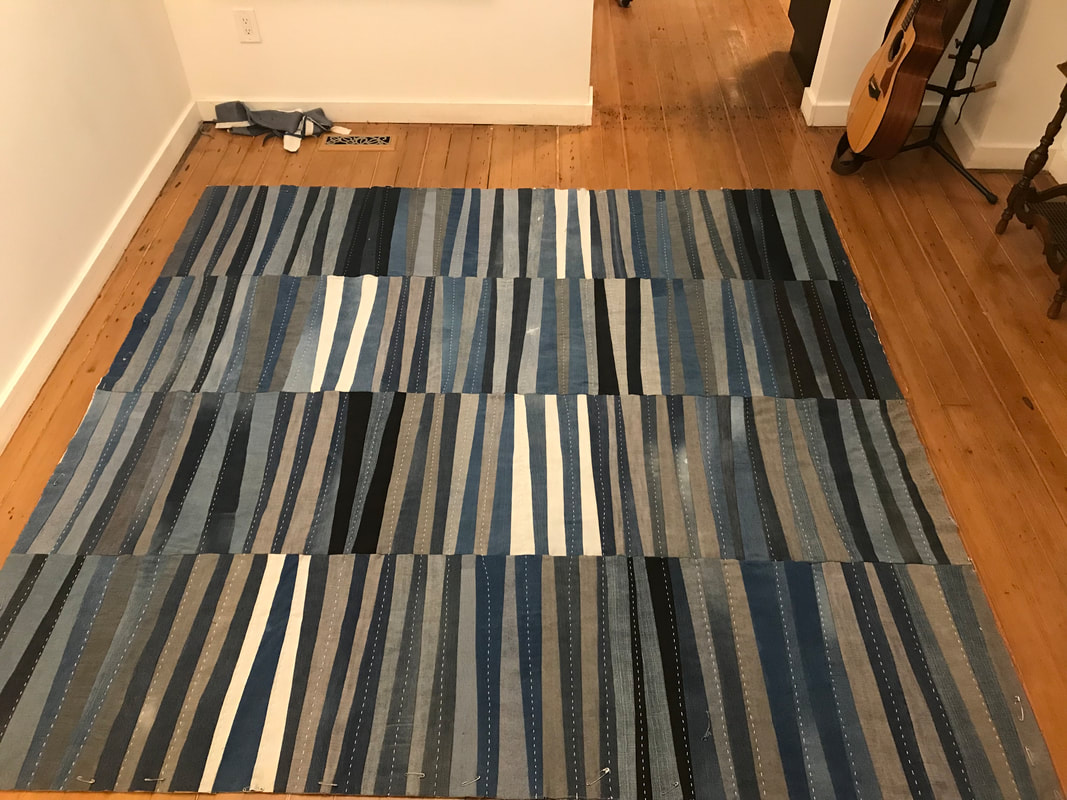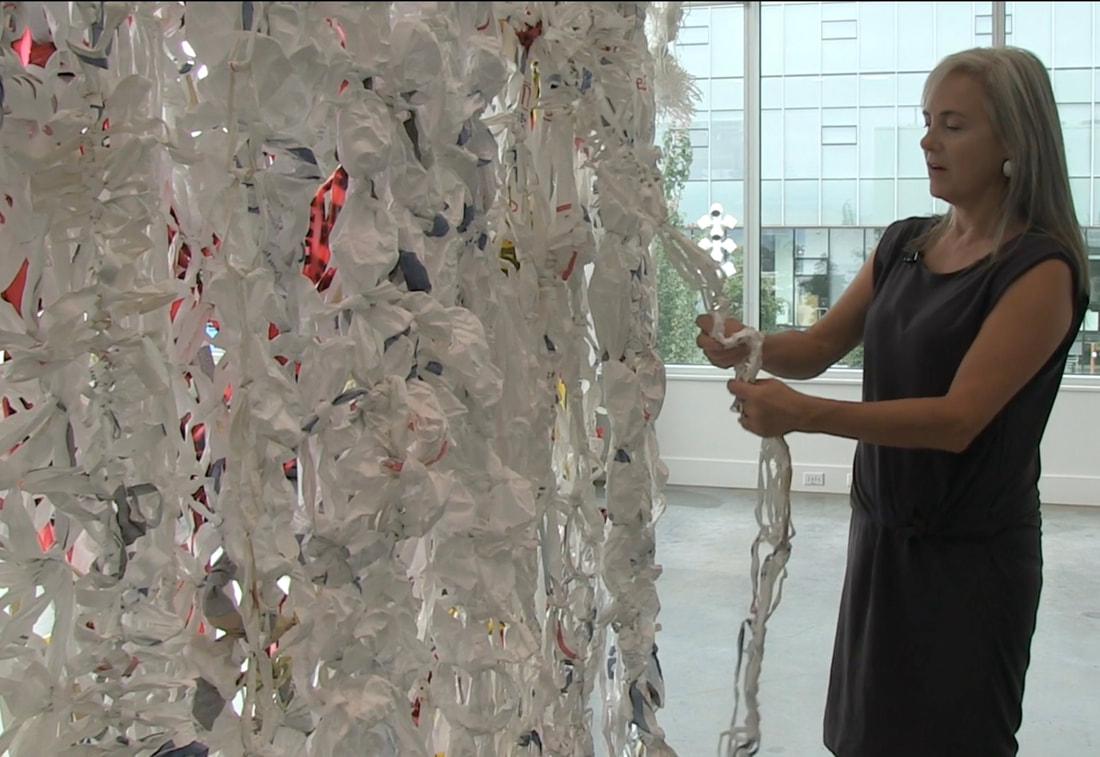
 Click HERE for a 10-minute journey through the methods and motivations behind this MFA thesis. (Film made by Ana Valine, Rodeo Queen Pictures, August 2020)
Dear Santa, I know I haven't written since I was a kid, and when it comes to wants, I'm pretty much good. Unlike a lot of my neighbours who rent homes that are slated for demolition in the coming year or who have to hit the food bank at the end of every month when the money runs out, I'm safe and secure — for now. You see, I'm a bit of a prepper. I worry about the security of all our food and the hikes in cost of living in the era of climate change so I've been doing workarounds for a lot of that. I have a kitchen garden and my main way of getting around is by bike. My work- and social life surrounds making, mostly with materials that have already served their primary purpose. If the power grid or the banks fail, I can at least charge up my bike lights and headlamps with my Biolite camp stove, using bits of cardboard and twigs so I can get out there and be of some use. My one weak spot, though, is heat. Condos with wood-burning fireplaces being a rarity in these parts, I would have no choice but to go outdoors and hang by the bonfires in the streets. 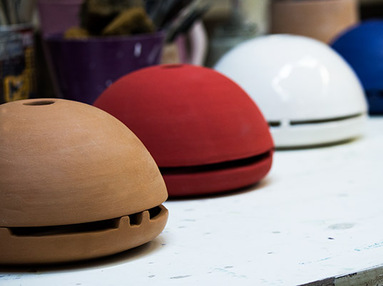 But now I see there is the Egloo, a table-top terracotta dome-thing that can throw off 70C degrees of radiant heat using just a few votive candles. Pant! Pant! It's the brainchild of Marco Zagaria, a student at the Academy of Fine Arts in Rome. Trouble is, it's not quite available yet. Zagaria has been hand-making the prototypes on a potter's wheel (promo video below) and is currently crowd-sourcing funding — already surpassing his goal by 15 per cent at the time of this writing — to have them mass-produced. So here's where you come in, Santa. I don't know if I can wait, what with us all teetering on this edge of the Ring of Fire and seismologists referring to the imminent major earthquake as The Big One. I figure if you can squeeze your girth into a gas fireplace exhaust vent you can put an Egloo under my tree pronto. However, as is my nature, I am prepped for the disaster of that not happening as well, so I've sourced some of Zagaria's own research and have latched onto a snippet of his virtual collaboration that he tagged as one of his YouTube 'favorites', a simple arrangement of one clay plot bolted inside another, resting on some thin cinderblocks. (See YouTube clip, at bottom.) It ain't pretty, but it will do the job in a pinch and uses stuff in my immediate vicinity. Just goes to show, it takes a creative like that Italian art student to arrive at that balance between form and function that marks brilliant industrial design, which begets attraction which begets demand which begets profit motive which begets financial backing which begets wide-scale production which begets marketing to preppers like me. What am I saying? — you're Santa. Surely you know all about the value of artists in economics and sustainability innovations. Wishfully, Carlyn It's not too late to say, Nay! I will not be coerced into this coming two-week commercial frenzy. I will steer my little ship into calmer waters! Instead of joining the throngs of harried consumers grabbing up plastic chocolate-pooping reindeer and ironic acrylic Christmas sweaters it's possible to turn all this Excessmas into Makemas — not to make gifts necessarily but just to make for the sake of it. 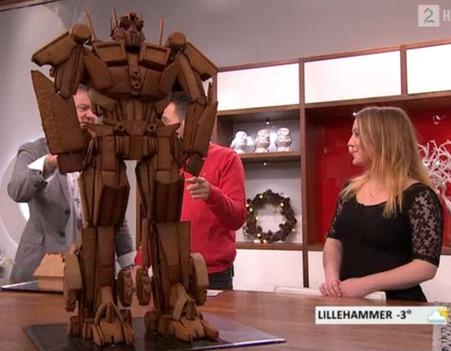 Eriksson's home-baked sculpture earns her a TV interview on God Morgen Norge. Eriksson's home-baked sculpture earns her a TV interview on God Morgen Norge. Seasonal materials — gingerbread, sugar, snow and ice, fir boughs, candy, lights — get makers going. What starts with a simple plan to make, say, a gingerbread house, can develop into astonishing works. Norwegian maker Caroline Eriksson took it to new heights last year when she devoted a week and a half of full-time making to compose this Optimus Prime (which really should have been called Insulin Prime). There are 700-800 pieces in this Pepperkokemann — which sounds really funny when you say it out loud. (via gizmodo) It's nerdy but there's something in all that cookie dough that evokes a delicious back story about a sweet gingerbread house that breaks out to lead the Autobot rebellion. 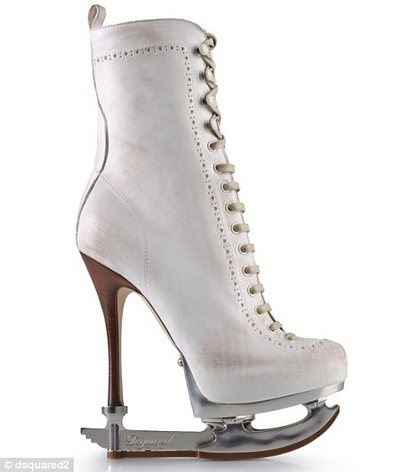 Jacking up this surrealist season is Toronto fashion shock-rockers Dean and Dan Caten(acci) of DSquared2, who created these spike-heel ice skates a couple of seasons back. I remain captivated by this very-Canadian wearable sculpture that the makers had the nerve to put into a product line, further blurring the line between surrealism and consumption. The power it has to create so much scorn says something about a culture immersed in acquisition over contemplation of an object. Adding to the cultural weight of this object is in the potential for performance art by the user. 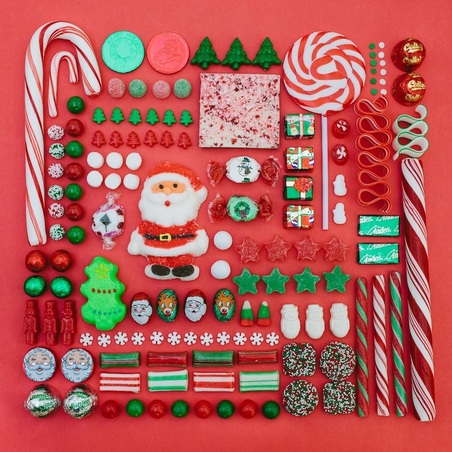 Austen, Texas artist Emily Blincoe packs a weighty punch into the empty calories of her Color Coded: Sugar Series. A surprising recategorization of common objects or materials invites a re-think about those objects. A glut of candy organized by colour draws the viewer's attention into issues like marketing, excess, presentation. consumption and value. This fetishistic display of tooth-rotting, diabetic-seizure-inducing "food" endures as long as the no-expiration dates. But when it's all too much (as Glaswegian Granny used to declare, on surveying the freshly unwrapped loot), we makers head for the woods. Or the beach — anywhere you won't hear the Chipmunks or Michael Buble or Mariah Carey droning seasonal mall music. 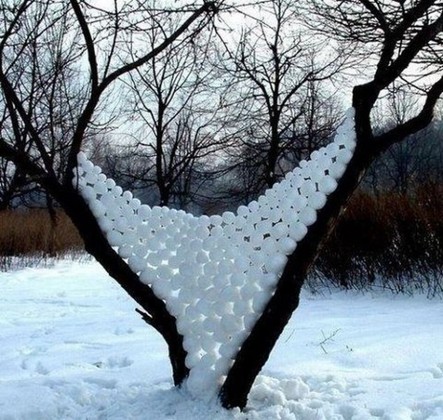 A snowball installation speaks the language of textile art. (from cecageorgieva.blogspot.ca) A snowball installation speaks the language of textile art. (from cecageorgieva.blogspot.ca) Making is also meditative. Textile artist Ceca Georgieva, of Sophia, Bulgaria, works in the natural world, creating time-intensive land art pieces. This snowball installation exudes quietude and fragility, created through a repetitive process that evokes the kind of attention and meditation involved in textile art. The impermanence of the piece, the precarious balance makes it an intriguing moment in time. Soon it will all blow over and we can start anew. It's getting close to a decade since I packed it all in: my needles and wool, my sewing machine and fabrics, my mid-level-management career. There was more to explore. I've been mixing it up with a wide range of materials (and makers) ever since but even I'm surprised to find that my latest tools of choice for bushwacking new routes of making are the ol' crochet hooks, knitting needles, rug hooks and embroidery needles. The line on the paper has always been too limiting to me; I need to pick up that line, play with it in my hands, turn it into area, then volume. I remain entranced by the possibilities of connecting something created by a silkworm or an industrial manufacturing plant to a mathematical model or a wearable with uncomfortable connotations. The beauty of fiber is in its physical and metaphorical ability to connect the Art side to the Design side (not to mention the science side), weaving the two together until it's clear that playing with ideas cannot be put into separate boxes. 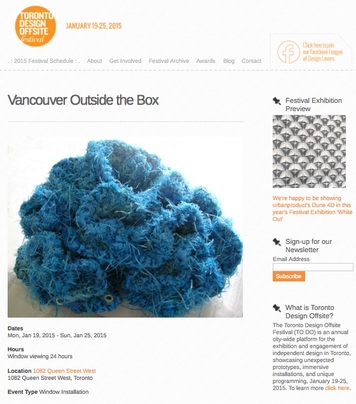 'Spore' (2011) serves as promo visual for the Vancouver design group. 'Spore' (2011) serves as promo visual for the Vancouver design group. Except if we're talking shipping boxes, for the Toronto Design Offsite (TO DO) Festival next month. A few object-experiments from my ongoing Fuzzy Logic series will be packed in there, as part of the Vancouver group of makers, selected by the Dear Human creative studio. It's all part of the ‘Outside the Box’ exhibits featuring works from three selected Canadian cities — Montreal, Calgary and Vancouver — and five from the U.S.: New York, Detroit, Chicago, Los Angeles and Seattle. It's a fine way to mine local design ideas and visions through an unexpected selection of objects that are shared in various locations via specific-sized shipping boxes. The Vancouver contribution includes nine individuals and teams who live, design and make in the greater Vancouver area. The connecting thread is a pursuit of a design practice through material exploration, according to Dear Human. "Whether through common applications of unusual materials or transcending common materials through unusual applications, exploration is evident in each of the included objects." Rounding out the Vancouver Outside the Box contingent are: Cathy Terepocki, Dahlhaus, Dina Gonzalez Mascaro, Hinterland Designs, Laura McKibbon, Rachael Ashe, and Studio Bup. 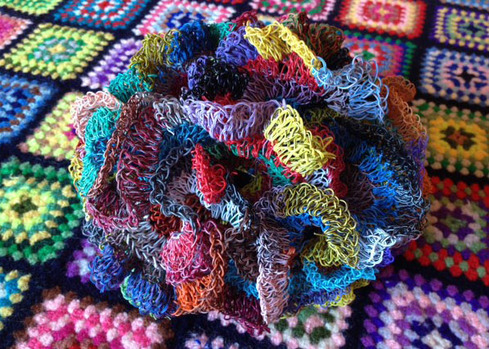 Playing with fiber optics (Photo by Carlyn Yandle) Playing with fiber optics (Photo by Carlyn Yandle) Vancouver Outside the Box will take over the windows at 1082 Queen Street West, Toronto, from January 19-25, 2015. TO DO is an annual city-wide not-for-profit week-long festival that celebrates and showcases the nation's design scene, providing exposure and cross-pollination of ideas and techniques. There are too many exhibits, installations, talks, parties and films to list here, so check out the full (and growing) schedule here as well as the fun promo video. 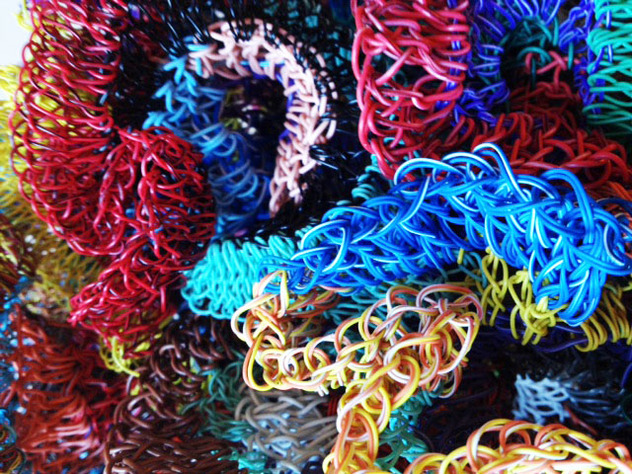 Detail of Fiber Optics (Photo by Carlyn Yandle) Detail of Fiber Optics (Photo by Carlyn Yandle) 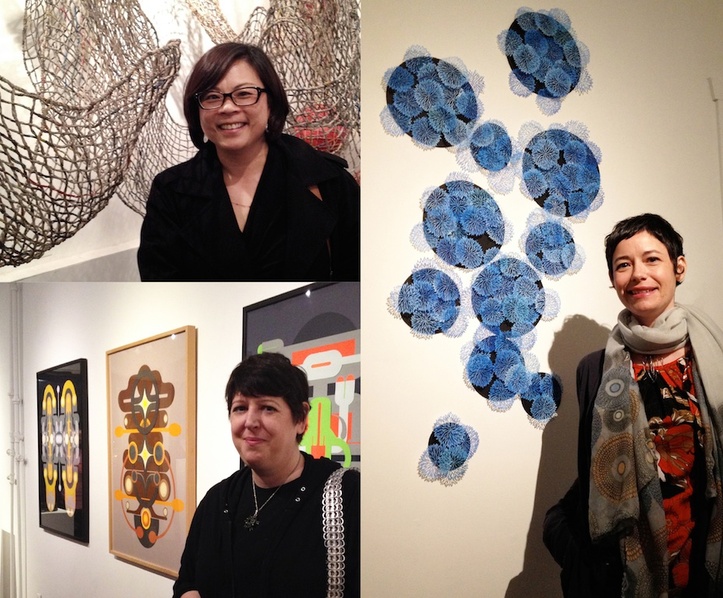 Clockwise from top: Connie Sabo, Rachael Ashe and Sarah Gee Miller with their respective works. (Carlyn Yandle photos) Clockwise from top: Connie Sabo, Rachael Ashe and Sarah Gee Miller with their respective works. (Carlyn Yandle photos) Sarah Gee Miller says she's pretty handy. That's the understatement of the evening. Her paper 'paintings' are not only visually stunning and conceptually rich but they resonate with the dedication of a serious craftsman. Funny how the word 'crafts' only gets the serious respect it deserves when the 'man' is attached to it. Suddenly the mind moves from, say, knitting or embroidering to, say, boat-building or blacksmithing. Here at the Voices from Another Room show at the Hot Art Wet City gallery, the craftsmanship is here in the medium of paper. It's that juxtaposition between the humble, ephemeral material and the heavy-duty skill and commitment of craftsmanship that makes this show of five artists' work so compelling. The results of that individual devotional patience, determination, repetition is on view. And I can attest that there's also frustration, physical exertion, second-guessing and the flops. You don't get to this calibre of work without enduring a few hard battles. The conceptual elements of the pieces in this group show may reference particular art genres (or not) but the methods are perhaps unconsciously rooted in this region that is built on a New World culture of self-sufficiency, innovation and handwork, in a medium fitting for this corner of the world that was built in large part on the pulp and paper industry. Location, whether in art or real estate, is everything. The beauty of the group show that has that one connecting thread — or in this case, wood fibre — is in how far that thread can be stretched, from Miller's totemic paintings to Sabo's heavy net-like installations of twisted newspaper, to Ashe's filigree screens, to Alison Woodward's three-dimensional twisted fairytale vignettes and Joseph Wu's origami sculptures. But beyond the medium there's the other connecting thread of craftsmanship, which Wu articulates as both a scientific and artistic exploration. This is a show of skill that is developed through the often meditative repetitive act of carving or twisting or folding, but the art is in the repetition of those expanding skills. It is how Sabo's net works have led her to ideas about laminating newspaper blocks, or how Miller's paper paintings grew out of her own drawing machine. "The open relation between problem solving and problem finding... builds and expands skills," according to author Richard Sennett in The Craftsman. "But this can't be a one-off event. Skill opens up in this way only because the rhythm of solving and opening up occurs again and again." Voices from Another Room: 5 Artists Explore Paper continues to April 25, Wed-Sat noon to 5 p.m. at 2206 Main (at 6th Ave.), Vancouver. 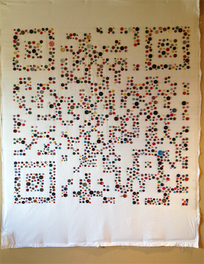 After three months of sewing one donated button after another into a giant QR code, the big moment arrived this week: time to stand back and scan that baby with a reader app, translating this quilt-thing to read, "The devil is in the details." Except it didn't read. Don't panic!, I thought, then spent the entire next day working with a photo image of the QR Button Blanket, Photoshopping in more buttons and darker buttons and bigger buttons, trying to add the minimum amount of density for the software program to register the pattern and work its magic to produce the punchline. No luck; even a sliver of white in one button cluster puts a wrench in the wholecloth works. I filed this one under the category of Epic Fail, not worth finishing it as intended, framing it in black bias binding. I do not want to create something that is 'still' good; I want the thing to be good, full stop. 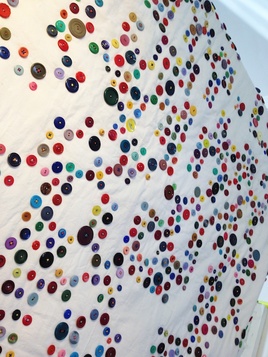 Failure demands confronting the why. Why conceive such a laborious, risky project in the first place? Why endure the painstaking process when half-way through it was becoming abundantly clear that this was not going to 'read'? But there is another power here, and that's tied to the process beyond the product. The achievement may lie in the endurance (in an increasingly A.D.D. world) that is not necessarily attached to the product after all. It may be in seeing it through, without the promise of a sure result. The power may lie in the humble, everyday materials and the community of women who contributed all those bits of plastic saved from the waste stream. (There should really be a global ban on production of billions of plastic buttons. Plant-based plastic, bone, wood, and leather- or fabric-wrapped tin buttons eventually return to the earth.) But what's really starting to click in for me is the cultural reference of this button-grid design. A decade ago, it might have been viewed as an oddly arranged colour field or an abstracted grid but we're so acclimatized to codes that the pattern begs to be 'read.' The fact that this is irresolvable might be annoying. And that's interesting. 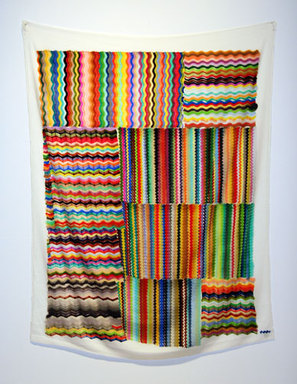 Wavy Gravy, marker on synthetic velvet, 58" x 43" Wavy Gravy, marker on synthetic velvet, 58" x 43" The possible multiple references could be more engaging than the one answer provided by a QR reader app. There's something to be learned in the discomfort of the open-endedness. Moments like these, I seek out the artists who have embraced what New York artist Polly Apfelbaum calls the 'tough beauty' of visually exciting works that incorporate everyday materials in surprising ways. Apfelbaum, who calls herself a bad crafter, articulates the process of hard work in this video. "I work all the time," she says, without a schedule and in a highly experimental way. "You make the work and then you hope for the best." "It's very important to get your fuck-you back." I'm going with that. 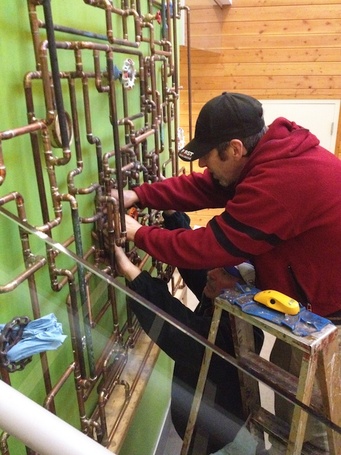 While the rest of us are scrambling to post our recent activity, build our brand, be a part of the online conversation, Noah is solving problems through metal. His underwhelming website is testimony to what he does instead all day long instead of sitting at a computer, often seven days a week, for money and for love. I found him through a trusted recommendation and knocked on his hand-crafted metal-ball door-knocker back in May, with my metal problem: I wanted to make a quilt out of reclaimed copper piping and other old gizmos. I had my pitch all ready to go, something along the lines of, "I know this sounds crazy but hear me out..." but I could see he was already loving the idea. "I really want to do it," he said, and I could see I had found the right craftsman for the job. For the next four months, Noah turned my full-size paper pattern pieces into two mirror-image, six-foot-square quilts of 10 lapping 'log cabin' blocks, which was installed in the front entrance of the City of North Vancouver's new Operations Centre last night, at the time of this posting. Sometimes ignorance is bliss. I didn't even know what brazing was when assemblage artist (and Noah's neighbour) Valerie Arntzen brought me around to his place. I didn't know that you can't just solder different metals together. I simply handed over the goodies I found at my favourite scrap yards (thank you for putting those gems aside, Richard of North Star Recycling and Dung of Allied Salvage). Apart from some initial head-scratching and smiling, Noah did not harp on the fact these were time-consuming challenges. Had I known the trouble he would take dissembling old spigots and repairing bronze pressure gauges I might have clawed back on the scrappy treasures. It also had not dawned on me that paper patterns might not be suitable in a workplace that is all fire and molten metal, a problem he solved by laying a thick piece of tempered glass between the patterns and the hot solder and copper. Problem-solving is the mark of fine craftsmanship. Noah claimed to like the quilter's block-by-block approach to creating complex pattern and texture. I appreciated the fact that he also saw visual value of keeping the soldering drips and the entire range of patinas of copper, from black to turquoise to new-penny pink, instead of polishing it all to a high sheen. That ability to let go of the need to create a perfect joint or a uniform result speaks to the artist in this craftsman. 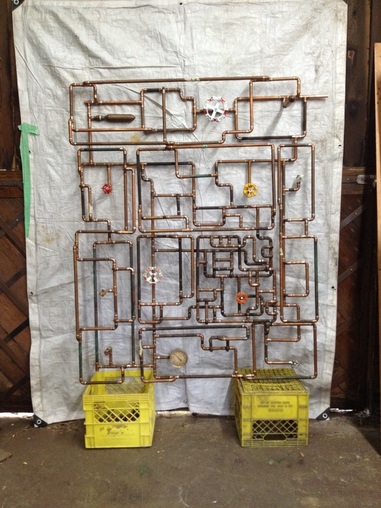 The nuts and bolts: Hand-drawn renderings were translated into an Illustrator file and printed out as full-size colour-coded block patterns to indicate three levels as well as placements for found features. Noah adjusted for the bulky tees and elbows as he transformed the patterns into a three-dimensional matrix, and situated specific gizmos to enhance the subtle mirror-image effect. There are many leaps of faith in the making of something never before attempted. No amount of sketching, Photoshop'd artist renderings or 3-D modelling can create the same sense of the actual thing in its intended space. So as City of North Vancouver workers passed by during the installation last night, joking about how it looked like their last job, or asking if we've checked for leaks, or pointing out some gizmo-relic they remember (including some donated from the City's own works yard), we were having our own first look at our collaborated effort. The glints of hand-rubbed corners and the deep shadows on the wall were all pulling together in this soaring, 12-foot-high structure. And... breathe out. Waterwork is working. Thank you, Noah. 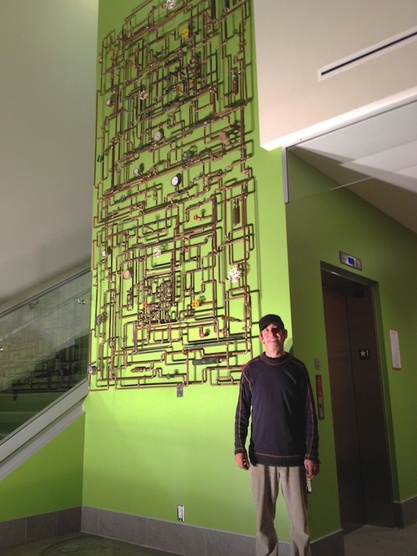 |
browse by topic:
All
Archives
October 2022
|
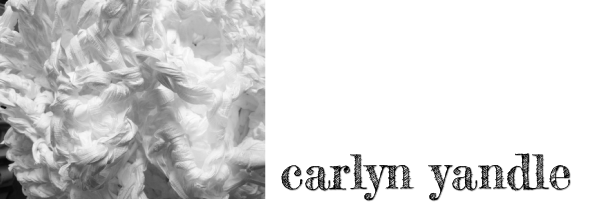
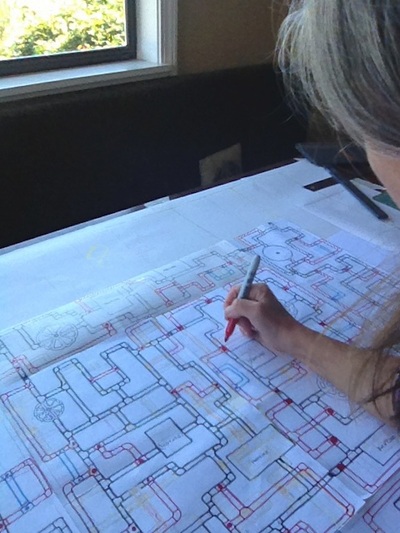
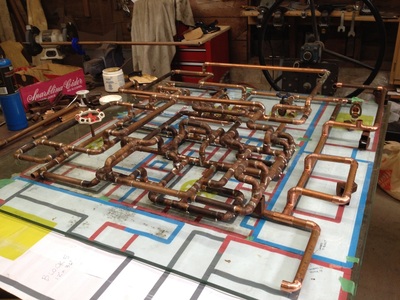
 RSS Feed
RSS Feed

